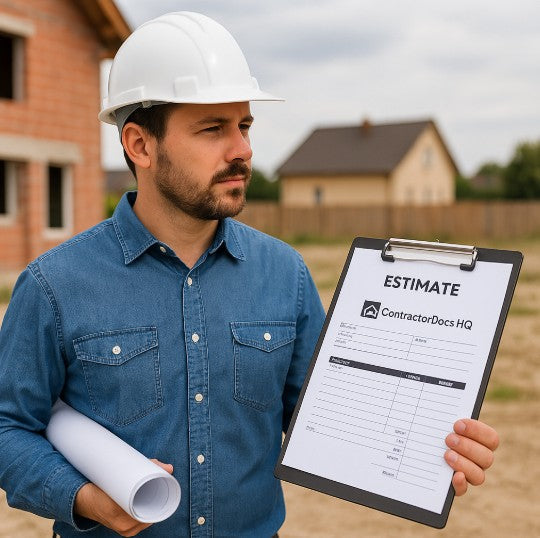
How to Perform a Professional Estimate for a Potential Client
Share
(Step-by-Step)
When a potential client reaches out for an estimate, your approach can either win the project — or lose it. Performing a clear, organized estimate not only helps you understand the job better but also shows your client you’re professional, detail-oriented, and trustworthy.
Here’s a step-by-step breakdown of how to perform a top-notch estimate — and how tools from ContractorDocs HQ make it even easier.
1. Initial Contact: Set Expectations
The process starts before you ever step foot on site.
- Respond quickly to the client’s inquiry.
- Schedule the site visit within a few days, if possible.
-
Ask questions ahead of time: What is the project? Budget range? Timeline expectations?
Setting the tone early shows professionalism and saves time.
2. Site Visit: Gather All the Details
When you arrive at the site, treat the visit like an interview — for both you and the client.
- Walk the entire site: Exterior and interior (if applicable).
- Take pictures: Capture every important angle — existing conditions, tricky areas, utilities, and surrounding access.
- Take notes: Write down anything the pictures don’t show clearly. Measurements, site access issues, material needs, etc.
- Ask questions:
- What finishes are they expecting?
- Are there any known site issues?
- Who’s responsible for permits and inspections?
- Are there any allowances (flooring, fixtures, equipment)?
- Discuss the full scope: Cover every trade that will touch the project — demolition, framing, electrical, HVAC, plumbing, painting, finishes, landscaping, etc.
✅ Tip: The more thorough you are now, the fewer surprises later.
3. Clarify and Organize the Scope
After the site visit, go back through your photos and notes and organize the scope clearly.
- Break the project into sections: Sitework, Concrete, Structure, Finishes, MEP (Mechanical, Electrical, Plumbing), Final Touches.
- Clarify anything you’re still unsure of — a quick follow-up call or email saves headaches later.
This is where ContractorDocs HQ Templates come in handy.
- Use the Scope of Work Template to write out all items clearly.
- Use the Budget Sheet Template to start assigning rough costs by trade and line item.
You’re already ahead of 90% of contractors who just throw a “ballpark” number together.
4. Create a Professional Estimate
Using the info you collected:
- Fill out your ContractorDocs HQ Budget Sheet to itemize every line of work.
- Adjust for markups, contingencies, and profit margins.
- Double-check material and labor costs against your supplier pricing or past projects.
- Attach photos if needed to explain areas that could trigger change orders later.
- If you’re ready, prepare a formal proposal using the ContractorDocs HQ Proposal Template — clear, structured, and easy to read.
5. Present Your Estimate Like a Pro
Instead of just emailing the number, schedule a quick review call or meeting.
- Walk through the scope together.
- Explain what’s included and excluded.
- Cover allowances and potential variables that could affect price.
- Show your professionalism by presenting organized documents — not just a single number scribbled in an email.
✅ Tip: Transparency builds trust, and trust wins projects.
6. Follow Up Strategically
After presenting the estimate:
- Thank them for the opportunity.
- Stay available for questions — sometimes clients need a few days to digest.
- Offer to make adjustments if the budget needs tightening (using the Revised Budget Template from ContractorDocs HQ if needed).
Final Thoughts: Why It Matters
A strong, organized estimating process is your first impression.
When you walk a jobsite with confidence, ask the right questions, take thorough notes, and deliver a professional estimate, you're already separating yourself from the "cheap and sloppy" competition.
With ContractorDocs HQ templates, you don’t just estimate a project — you win it.
👉 Need templates to get started?
Download your Budget Sheet, Scope of Work Outline, and Full Proposal Templates at ContractorDocsHQ.com.